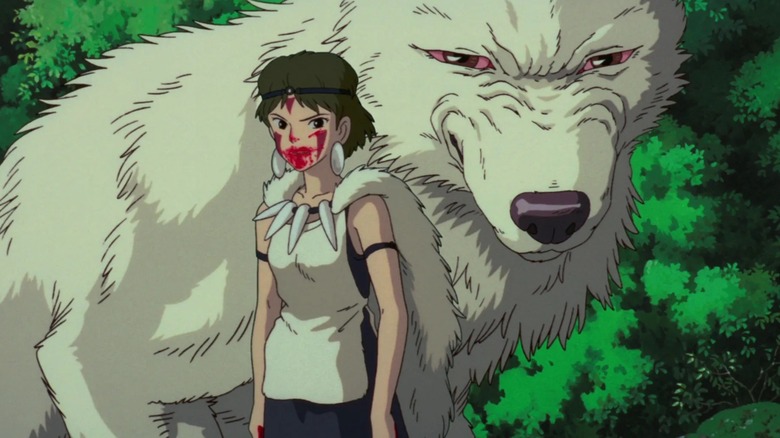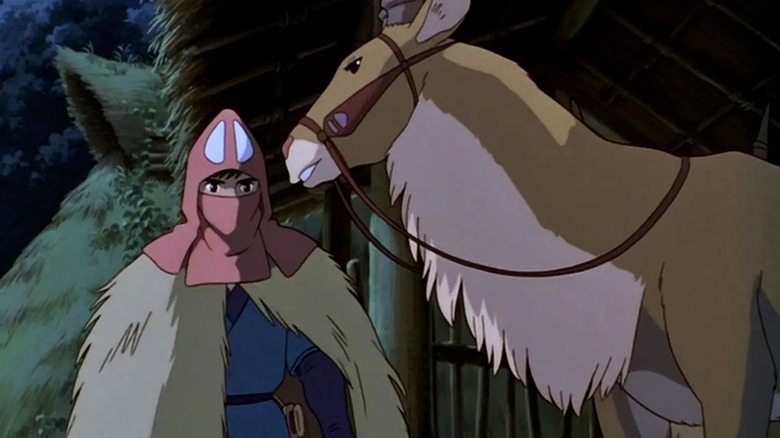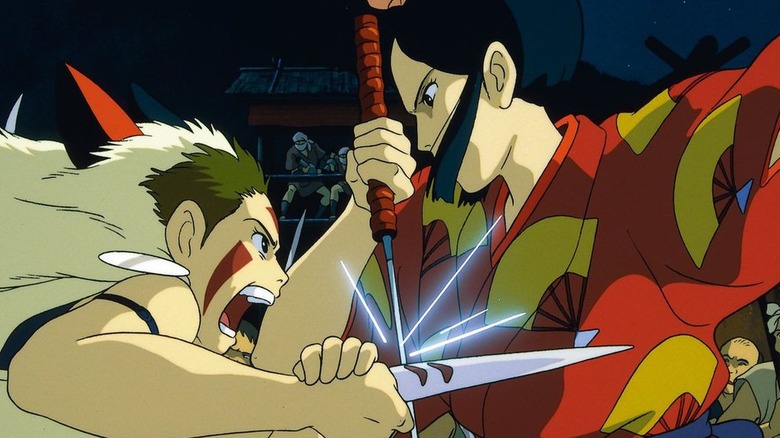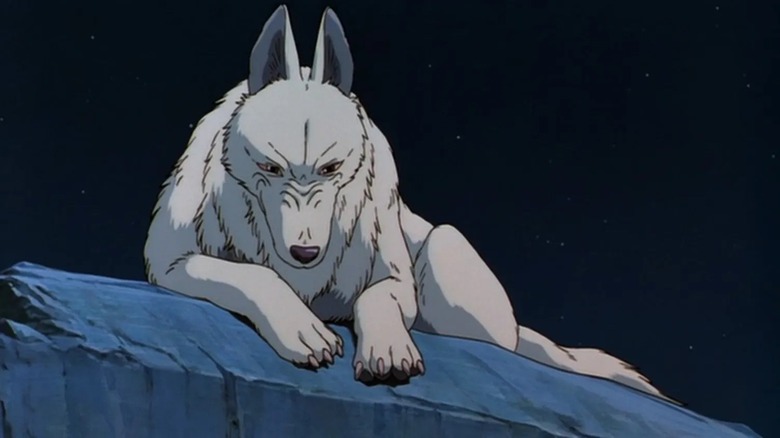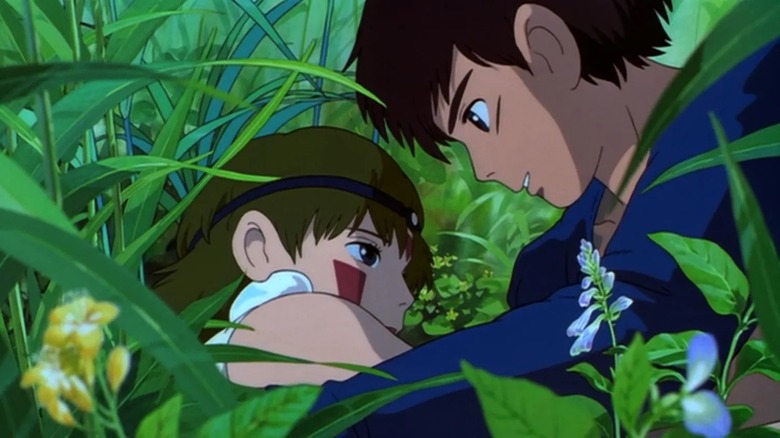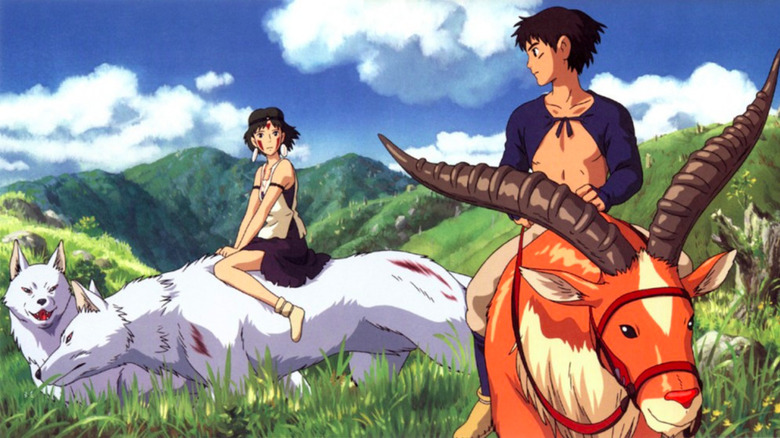Princess Mononoke Ending Explained: Death And Rebirth In The Forest
Though the title of writer-director Hayao Miyazaki's "Princess Mononoke" makes it sound like a proper name, it's really a nickname and translation preserving the loaded word mononoke from the movie's Japanese title, "Mononoke-hime" (with hime meaning "princess"). Mononoke is an umbrella term that covers a whole plethora of wrathful spirits in Japanese folklore, which makes the title of Miyazaki and Studio Ghibli's 1997 animated classic more akin to something like "Princess of the Angry Gods."
That's one key thing that might help the viewer "see with eyes unclouded" — like the cursed prince, Ashitaka — and thereby understand the ending of "Princess Mononoke" a little better. In his original project proposal for "Princess Mononoke," Miyazaki hinted at the nature of that ending (which we'll be analyzing here with spoilers), saying, "There cannot be a happy ending to the fight between the raging gods and humans. However, even in the middle of hatred and killings, there are things worth living for."
Commentators have described "Princess Mononoke" as "a reaction to My Neighbor Totoro"—more specifically, a reaction to the audience reaction to Miyazaki's 1988 movie, which supplied Ghibli with its mascot and targeted kids with a cuddlier form of the environmentalism running all throughout the great animator's filmography. It's certainly not the first Ghibli feature where deforestation stirs up trouble. We see that, too, in "Pom Poko," which, despite its comical, anthropomorphic raccoon dogs, almost verges on folk horror at one point with its depiction of their shapeshifting Hyakki Yagyō, or Night Parade of 100 Demons.
"Princess Mononoke" continued the maturation of Miyazaki's thematic concerns by introducing us to a nominal "princess" who hates humans and makes a strong first impression by sucking and spitting blood from the wound of the immortal white wolf who raised her.
The last Emishi prince
The ending of "Princess Mononoke" comes full circle to where the movie started: with a possessed boar god turned into a demon. The blind Okkoto takes the place of Nago, the boar covered in black worms who went on a spidery rampage in the opening 10 minutes.
"Princess Mononoke" follows the hero's journey model at the beginning, with Ashitaka's call to adventure on the back of his red elk occurring after he's touched by the forest through Nago. It leaves him marked for death with a necrotic arm that nonetheless gives him the strength of 10 men, capable of bending swords and severing the arms and heads of samurai with a single arrow.
A crucial facet of Ashitaka's character, which may be lost on some Western viewers, is that he is a member of the Emishi ethnic group — the last prince, in fact, of his nearly extinct tribe. This makes him an outsider even among the other human characters, most of whom are part of the encroachment of Japanese civilization on the forest. Both sides of the conflict between the titular mononoke princess, San, and the leader of the industrial Irontown settlement, Lady Eboshi, accuse Ashitaka of being on the other side.
Dual natures
As the movie goes on, we learn that Lady Eboshi was responsible for shooting Nago with a musket and driving him out of his territory. "You stole the boar's woods and made a monster of him," Ashitaka says. Yet as much as Lady Eboshi might resemble an eyebrow-arching villain at times, she is also described as kind and the only person who ever treated Irontown's bandaged lepers as human. In her and San — who fights for the forest with little care for the collateral human damage she causes — we see the same dual nature.
Ashitaka's own dual nature is manifested physically: his cursed right hand wants to kill Lady Eboshi, while his unaffected human hand wants to hold it back. More than once, he questions aloud whether humans and the forest can live in peace.
Man versus nature
As San and Lady Eboshi, the forces of industry and nature, cross blades in Irontown, Ashitaka gets between them and tries to mediate. On the one hand, this is an admirable aim, but on the other hand, his refusal to commit to a side leaves him ineffectual to prevent the larger tragedy that plays out as human scouts in boar skins trick Okkoto into leading them to the Shishigami (Deer God or Forest Spirit). Accordingly, his pleas to Lady Eboshi that the Shishigami is not her enemy fall on deaf ears.
The Shishigami also has a duality that is manifested in the transformation from its daytime form to the towering figure of the Night Walker. Its pond has healing powers and Lady Eboshi thinks its blood can cure disease, but at the end, we see that it is the god of both life and death as it kills the wounded Okkoto and Moro.
Nature can be inhospitable if not outright hostile to humans, sending disasters that cause indiscriminate harm — something Japan knows about all too well, with the threat of earthquakes, tsunamis, typhoons, volcano eruptions, and the like looming over the island nation at different intervals. In "Princess Mononoke," the monk who is after the Shishigami's head on behalf of the Emperor also speaks of a flood or landslide wiping out a village. Yet in real life, humans are just as capable of exploiting the environment and maybe even bringing some calamities on themselves as a species, through climate change.
Death and rebirth
"Princess Mononoke" depicts the clash between human civilization and nature in the Muromachi period, described by Miyazaki in his proposal as a "confusing era" where Japan "went through the process of moving from the collapse of the system in the medieval era towards the modern era." It's a time he held up as a mirror to contemporary society with its sweeping premillennial changes circa the late 1990s.
While "Princess Mononoke" is a historical fantasy, it is not a fairytale where everyone lives happily ever after. The Shishigami, Moro, and Okkoto die, Lady Eboshi loses an arm, and Ashitaka and San go their separate ways, with the latter saying she can never forgive the human race. Ashitaka, however, maintains that the Shishigami "can't die" because "he is life itself." There's a sense of rebirth that immediately accompanies his passing, as flowers bloom, the grass grows green again, and the curse on Ashitaka is lifted, with kodama sprites reemerging in the forest.
"He is telling us we should live," Ashitaka says.
Seasons and cycles
And so life will go on in "Princess Mononoke," with neither the protagonist, San, nor antagonist, Lady Eboshi, entirely triumphing. Questions of who is more right than wrong and where the best balance of perspective lies are left to Ashitaka and the viewer to interpret.
Lady Eboshi talks of starting over and building a good village, while Ashitaka gives hope that he and San can visit each other and perhaps peacefully co-exist as they live apart in the forest and the ironworks but together on the same earth. In the end, "Princess Mononoke" is movie that does not offer pat solutions but is comfortable with leaving the eternal man vs. nature dispute unresolved as it leans into the seasons and cycles of history.
